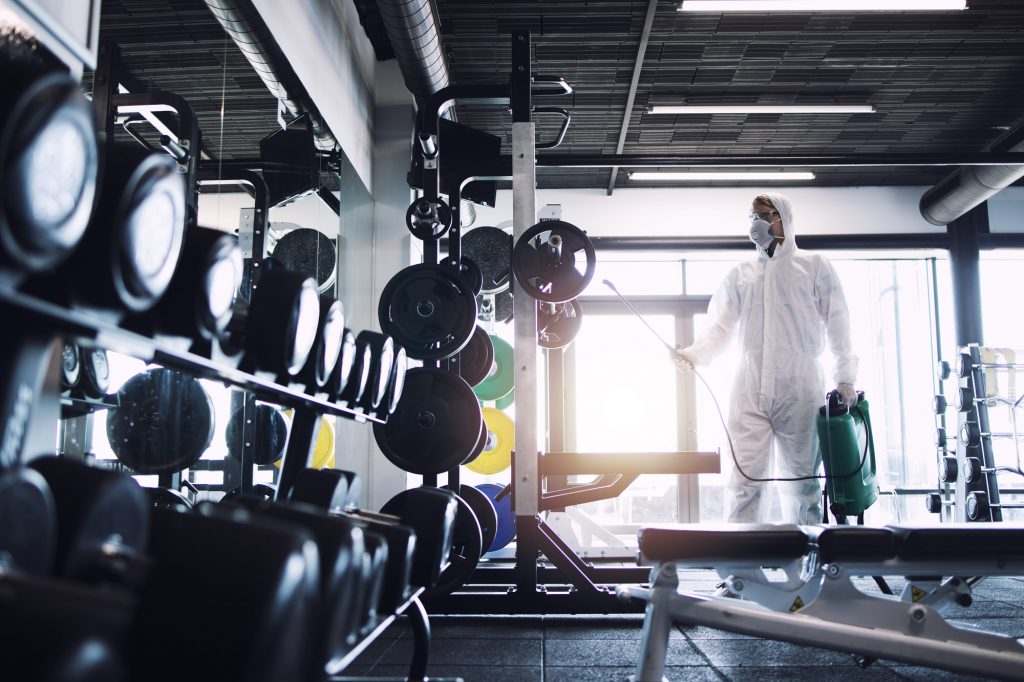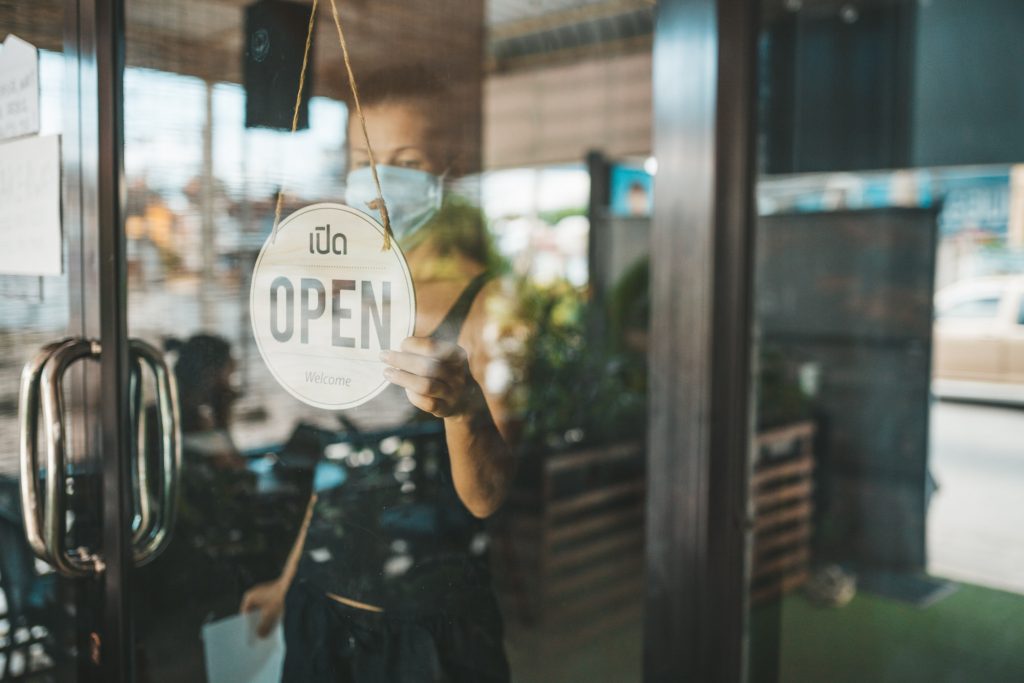
What do I do if my employee tests positive for COVID-19?
If you or one of your employees is confirmed with COVID-19, inform other employees of their possible exposure to COVID-19. Adhere to HIPAA guidelines.
Immediately call us at 617-299-1880 and our Boston-based “Rapid Response Sterile Team” will be dispatched to your site to sterilize your location. Our average response time is 1 hour.
After disinfecting your premises, we will work with your to build a comprehensive COVID-19 prevention plan.
Questions about Sterile Guys’ Boston COVID-19 Cleaning & Sterilizing services
Cleaning removes dirt, grime, germs, etc. from surfaces and objects with the use of soap and water. This process attempts to remove easy to reach germs, but does not always kill them.
Sterilizing kills germs through the use of chemical solutions sprayed on surfaces or objects.
Sterile Guys specialize in the use of innovative electrostatic spray technology to perform a quick, but efficient and effective disinfecting of spaces using EPA-approved, List N, non-toxic solution.
Our process allows for your team to immediately immediate re-entry into your space following our service. This system has been used in businesses, schools, hotels, vehicles, and the healthcare industry.
Electrostatic Spraying breaks down traditional manual-sprayer size droplets into numerous smaller micron droplets. This provides for even coverage of targeted surfaces – high touch areas, work spaces, living areas, etc.
Our electrostatic sprayers uses electricity to charge the chemical droplets as they are propelled from the machine. The disinfectant solution is then atomized, released, and wraps around surfaces – especially in hard to reach places and oddly shaped objects.
YES! It’s registered and approved with the EPA for use in healthcare, institutional, and residential applications. It is also on the List N, which means it can kill a harder-to-kill pathogen than COVID-19.
YES! It’s registered and approved with the EPA for use in healthcare, institutional, and residential applications. It is also on the List N, which means it can kill a harder-to-kill pathogen than COVID-19.
Our equipment and process allows one Sterile Guy to sterilize up to 15,000 square feet per hour.
It won’t be. Our solution has been tested and has no re-entry time. This means that it is safe for bystanders to re-enter the room immediately after we have completed spraying.
No. Our solution is not scented and will not leave behind any smells.
CDC guidelines recommend first removing the infected person from the premises via the same route of entry, whilst they wear a mask to keep others safe. It is important to then clear all personnel from any areas the infected individual was in, and to enact a sterilizing plan. Call us, and our Rapid Response Sterile Team and we can assist with your plan. Our average response time is one hour.
That’s a tough question. That depends on the type of surface. It can live for just a few hours on some, and up to 28 days on others. It is not recommended to simply wait for the virus to die by itself as not all surface materials have been tested to see how long it can survive.
Room fogging equipment has been proven effective for some viruses, however, there is currently no fogger equipment approved by the CDC to battle COVID-19. We adhere to CDC recommendations of first cleaning surfaces and then disinfecting with an EPA approved solution for harder-to-kill pathogens.
Lorem ipsum dolor sit amet, consectetur adipiscing elit, sed do eiusmod tempor incididunt ut labore et dolore magna aliqua. Ut enim ad minim veniam, quis nostrud exercitation ullamco laboris nisi ut aliquip ex ea commodo consequat.
Lorem ipsum dolor sit amet, consectetur adipiscing elit, sed do eiusmod tempor incididunt ut labore et dolore magna aliqua. Ut enim ad minim veniam, quis nostrud exercitation ullamco laboris nisi ut aliquip ex ea commodo consequat.
Questions about employer responsibilities regarding Boston COVID-19 Precautions
The General Duty Clause, Section 5(a)(1) of the Occupational Safety and Health (OSH) Act of 1970, 29 USC 654(a)(1), which requires employers to furnish to each worker “employment and a place of employment, which are free from recognized hazards that are causing or are likely to cause death or serious physical harm.”
OSHA requirements apply to preventing occupational exposure to SARS-CoV-2. Among the most relevant are:
OSHA’s Personal Protective Equipment (PPE) standards (in general industry, 29 CFR 1910 Subpart I), and, in construction, 29 CFR 1926 Subpart E), which require using gloves, eye and face protection, and respiratory protection when job hazards warrant it.When respirators are necessary to protect workers, employers must implement a comprehensive respiratory protection program in accordance with the Respiratory Protection standard (29 CFR 1910.134).
The General Duty Clause, Section 5(a)(1) of the Occupational Safety and Health (OSH) Act of 1970, 29 USC 654(a)(1), which requires employers to furnish to each worker “employment and a place of employment, which are free from recognized hazards that are causing or are likely to cause death or serious physical harm.”
OSHA’s Bloodborne Pathogens standard (29 CFR 1910.1030) applies to occupational exposure to human blood and other potentially infectious materials that typically do not include respiratory secretions that may contain SARS-CoV-2 (unless visible blood is present). However, the provisions of the standard offer a framework that may help control some sources of the virus, including exposures to body fluids (e.g., respiratory secretions) not covered by the standard.
State Standards
There are 28 OSHA-approved State Plans, operating statewide occupational safety and health programs. State Plans are required to have standards and enforcement programs that are at least as effective as OSHA’s and may have different or more stringent requirements.
The California Division of Occupational Safety and Health (Cal/OSHA) Aerosol Transmissible Diseases (ATD) standard is aimed at preventing worker illness from infectious diseases that can be transmitted by inhaling air that contains viruses (including SARS-CoV-2), bacteria or other disease-causing organisms. While the Cal/OSHA ATD standard is only mandatory for certain healthcare employers in California, it may provide useful guidance for protecting other workers exposed to SARS-CoV-2.
Employers must also protect their workers from exposure to hazardous chemicals used for cleaning and disinfection. Employers should be aware that common sanitizers and sterilizers could contain hazardous chemicals. Where workers are exposed to hazardous chemicals, employers must comply with OSHA’s Hazard Communication standard (in general industry, 29 CFR 1910.1200), Personal Protective Equipment standards (in general industry, 29 CFR 1910 Subpart I, and, in construction, 29 CFR 1926 Subpart E), and other applicable OSHA chemical standards. OSHA provides information about hazardous chemicals used in hospitals in the Housekeeping section of its Hospital eTool
OSHA has clauses that require an employer to protect their employees from recognized hazards. Disinfecting for COVID-19 demands that certain regulatory requirements for PPE, respirators, and approved disinfectants must be followed. We, therefore, recommend leaving the sterilizing to the professionals and not having your own employees attempt to disinfect.

